#snowy sheathbill
Text
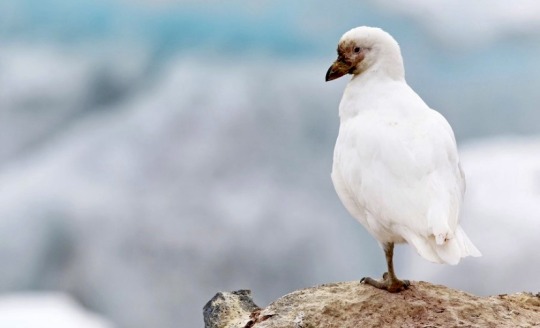



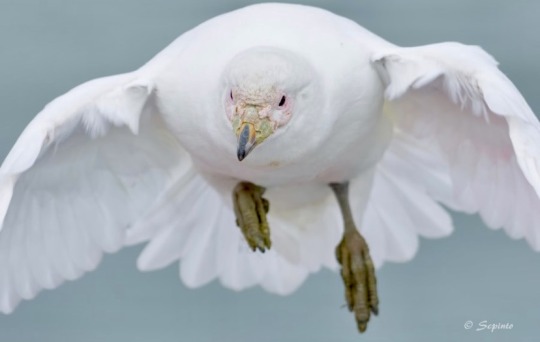
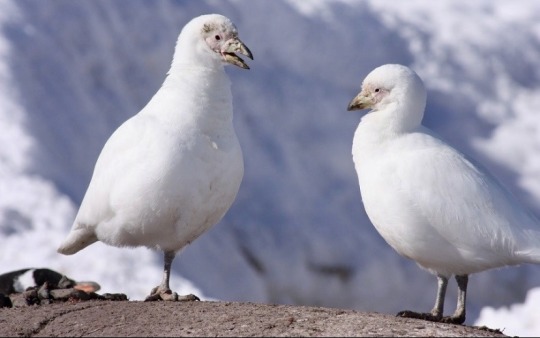
the snowy sheathbill is one of two species of sheathbill, and the only land bird native to antarctica. they are omnivorous scavengers that also engage in kleptoparasitism (stealing food from other birds). they have a varied and sometimes questionable diet, consuming everything from krill to tapeworms and waste. these birds are solid white, with a bare pink face. they are easily distinguished from the only other sheathbill, the black-faced sheathbill, which has a distinctive black bill.
470 notes
·
View notes
Text
BOTD: Snowy Sheathbill

^Image credit: Gordon Leggett
Snowy Sheathbill (Chionis albus)
The Snowy Sheathbill is the only land bird native to the continent of Antarctica. It does not have webbed feet, and finds its food on land - it is an omnivorous scavenger and kleptoparasite, eating nearly anything. They are one of two species of sheathbill.
#snowy sheathbill#chionis albus#birds of antarctica#birdwatching#birding#tropical birds#birds#bird#ornithology#bird facts#bird fact#bird of the day#bird fact of the day#birdfactoftheday#animal facts#aves
97 notes
·
View notes
Text
BRACKET C
Snowy Sheathbill (Chionis albus)
Taken from one nomination, “Gross diet of trash, stolen regurgitated food, feces, tapeworms, human waste.” They’re the only land birds native to the Antarctic continent. Taken from their Wikipedia page, “Sheathbills that are actively hunting for food spend approximately 38% of the day hunting, 20% of the time eating their prey, 23% just resting, 14% doing various comfortable activities, and the final 3% will be towards agonistic behavior.” They love eating tapeworms directly from the intestines of other birds.
VERSUS
Anhinga (Anhinga anhinga)
They swim around with only their heads out of the water, and spend most of their daylight hours just drying off their wings because for some fucking reason (it makes them better divers) their feathers aren’t waterproof. They use their long beaks like spears while fishing and they don’t have nostrils.

19 notes
·
View notes
Text

A scavenger who survives in the toughest environment vs a handsome creature.
Snowy sheathbills are the only land birds native to Antarctica. They can also be found on certain South Atlantic islands. As a terrestrial shorebird, it’s a bit of an anomaly. They don’t have webbed feet, so they aren’t built for the sea and forage on land instead. These resilient critters feed by scavenging and kleptoparasitism and will eat nearly anything: invertebrates, fish and krill stolen from penguins, eggs, carrion, garbage, and even feces and tapeworms! An interesting habit that snowy sheathbills have is that they almost always stand on one leg to avoid heat loss. Even when landing, they only use one leg so they won’t get both feet cold.
Egyptian plovers are the only species in their family Pluvianidae. They live in tropical sub-Saharan Africa, and, interestingly, not in modern-day Egypt; they are called Egyptian plovers because the territory they live in used to be ruled by Egypt. These handsome birds are found mostly on sandbars in slow-flowing rivers. They use an unusual method of nesting: they bury the eggs in warm sand, then sit on top of them with a water-soaked belly to control the temperature. Adults may temporarily bury chicks in the sand too to hide them from potential dangers.
10 notes
·
View notes
Text
The Tip of Antarctica
On our penultimate day at sea, Captain Cardestig skillfully navigated the Viking Octantis around the peninsula’s northeastern tip for an early morning view of Joinville Island’s glacial headlands and ice-capped peaks.
We anchored outside a dense track of pack ice that can make it challenging to approach landfall at Tay Head.
Those fortunate enough to be scheduled for daily excursions…

View On WordPress
0 notes
Text
Although not web-footed, from some unaccountable habit, it is frequently met with far out at sea.
"Journal of Researches into the Natural History and Geology of the Countries Visited During the Voyage of H.M.S. Beagle Round the World, 1832-36" - Charles Darwin
#book quote#the voyage of the beagle#charles darwin#nonfiction#snowy sheathbill#bird#chionis alba#seabird
0 notes
Photo

A new variant has been added!
Snowy Sheathbill (Chionis albus)
© Nicolas Huet & Jean-Gabriel Prêtre
It hatches from aberrant, alight, clean, few, green, naked, orange, pale, southern, stiff, stocky, unafraid, unique, and white eggs.
squawkoverflow - the ultimate bird collecting game
🥚 hatch ❤️ collect 🤝 connect
0 notes
Text
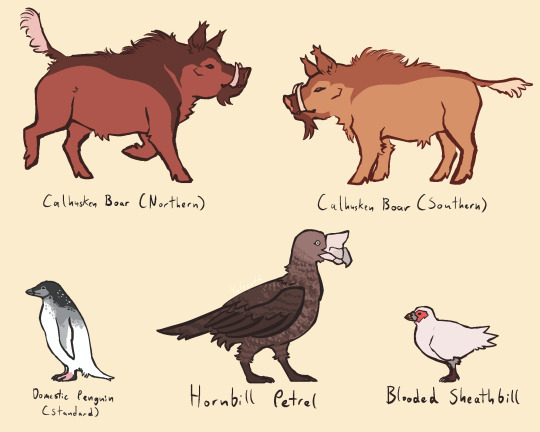
some fictional animal species for one of my fantasy settings
#minerva#speculative evolution#digital art#pcreate#fantasy#some are p close to inspo like the blooded sheathbill being heavily based on the snowy sheathbill
94 notes
·
View notes
Note
trick or treat 🎃
Congratulations on two (2) snowy sheathbills

60 notes
·
View notes
Text
Working on wekeks design rn:DD veeery happy with it so far
Hes based off snowy sheathbills (new favorite bird go look at them they're so cool), Humboldt penguins, pigeons, and caribou
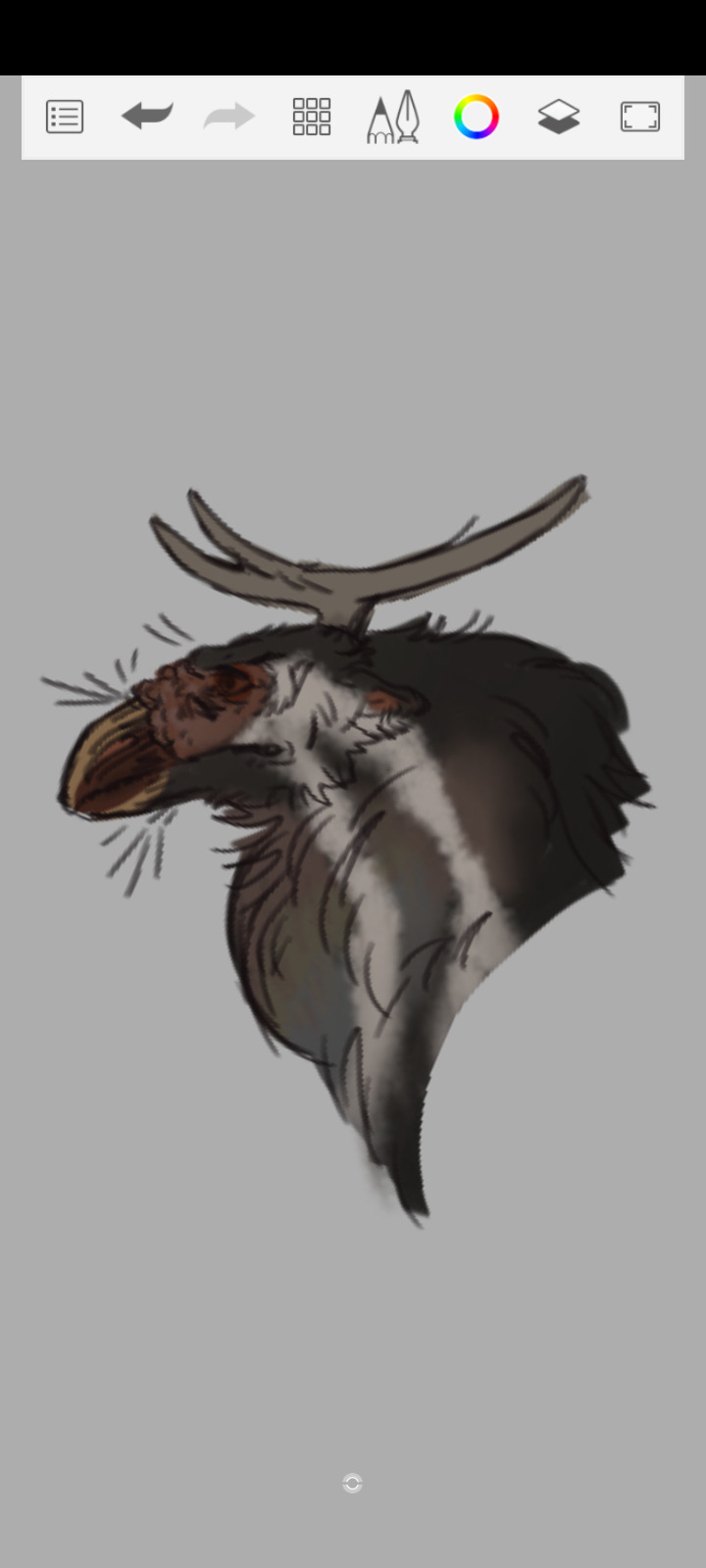
40 notes
·
View notes
Text
I don't really talk about my aus on here, but I'm pretty proud of the work I've put into this one so I thought I'd share
Nobody ask how long this took.
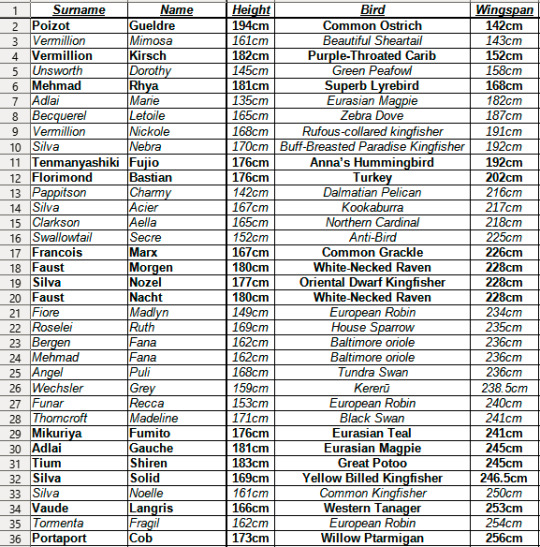
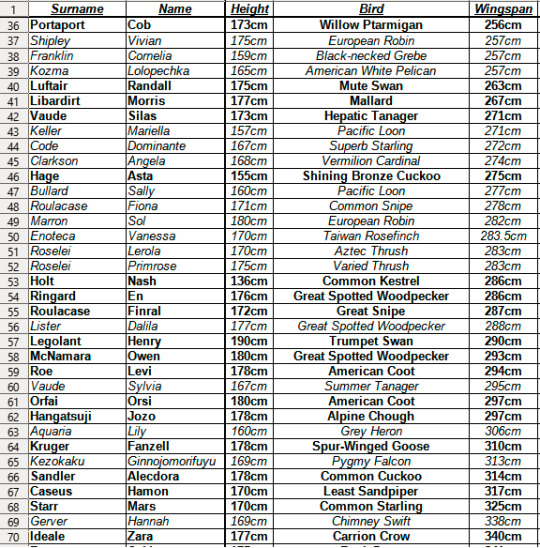
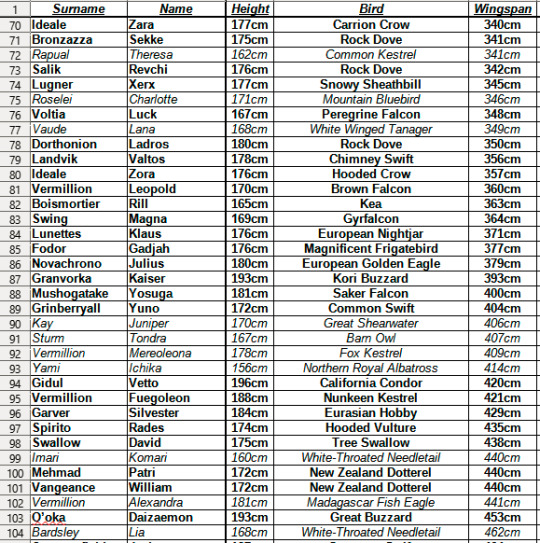

As per usual, several of the ocs on this list (Nickole, Bastian, Aella, Madlyn, Ruth, Madeline, Vivian, Cornelia, Silas, Angela, Primrose, Lerola, Dalila, Levi, Sylvia, Hannah, Juniper, Silvester, Alexandra and Alderbrand) belong to the lovely @crazedstoryteller, the rest of the ocs (Fiona, Lana, Tondra and Lia) are mine, and obviously canon chracters are canon
(alternate version of the table under the cut)
Surname Name Height Bird Wingspan
Poizot Gueldre 194cm Common Ostrich 142cm
Vermillion Mimosa 161cm Beautiful Sheartail 143cm
Vermillion Kirsch 182cm Purple-Throated Carib 152cm
Unsworth Dorothy 145cm Green Peafowl 158cm
Mehmad Rhya 181cm Superb Lyrebird 168cm
Adlai Marie 135cm Eurasian Magpie 182cm
Becquerel Letoile 165cm Zebra Dove 187cm
Vermillion Nickole 168cm Rufous-collared kingfisher 191cm
Silva Nebra 170cm Buff-Breasted Paradise Kingfisher 192cm
Tenmanyashiki Fujio 176cm Anna’s Hummingbird 192cm
Florimond Bastian 176cm Turkey 202cm
Pappitson Charmy 142cm Dalmatian Pelican 216cm
Silva Acier 167cm Kookaburra 217cm
Clarkson Aella 165cm Northern Cardinal 218cm
Swallowtail Secre 152cm Anti-Bird 225cm
Francois Marx 167cm Common Grackle 226cm
Faust Morgen 180cm White-Necked Raven 228cm
Silva Nozel 177cm Oriental Dwarf Kingfisher 228cm
Faust Nacht 180cm White-Necked Raven 228cm
Fiore Madlyn 149cm European Robin 234cm
Roselei Ruth 169cm House Sparrow 235cm
Bergen Fana 162cm Baltimore oriole 236cm
Mehmad Fana 162cm Baltimore oriole 236cm
Angel Puli 168cm Tundra Swan 236cm
Wechsler Grey 159cm Kererū 238.5cm
Funar Recca 153cm European Robin 240cm
Thorncroft Madeline 171cm Black Swan 241cm
Mikuriya Fumito 176cm Eurasian Teal 241cm
Adlai Gauche 181cm Eurasian Magpie 245cm
Tium Shiren 183cm Great Potoo 245cm
Silva Solid 169cm Yellow Billed Kingfisher 246.5cm
Silva Noelle 161cm Common Kingfisher 250cm
Vaude Langris 166cm Western Tanager 253cm
Tormenta Fragil 162cm European Robin 254cm
Portaport Cob 173cm Willow Ptarmigan 256cm
Shipley Vivian 175cm European Robin 257cm
Franklin Cornelia 159cm Black-necked Grebe 257cm
Kozma Lolopechka 165cm American White Pelican 257cm
Luftair Randall 175cm Mute Swan 263cm
Libardirt Morris 177cm Mallard 267cm
Vaude Silas 173cm Hepatic Tanager 271cm
Keller Mariella 157cm Pacific Loon 271cm
Code Dominante 167cm Superb Starling 272cm
Clarkson Angela 168cm Vermilion Cardinal 274cm
Hage Asta 155cm Shining Bronze Cuckoo 275cm
Bullard Sally 160cm Pacific Loon 277cm
Roulacase Fiona 171cm Common Snipe 278cm
Marron Sol 180cm European Robin 282cm
Enoteca Vanessa 170cm Taiwan Rosefinch 283.5cm
Roselei Lerola 170cm Aztec Thrush 283cm
Roselei Primrose 175cm Varied Thrush 283cm
Holt Nash 136cm Common Kestrel 286cm
Ringard En 176cm Great Spotted Woodpecker 286cm
Roulacase Finral 172cm Great Snipe 287cm
Lister Dalila 177cm Great Spotted Woodpecker 288cm
Legolant Henry 190cm Trumpet Swan 290cm
McNamara Owen 180cm Great Spotted Woodpecker 293cm
Roe Levi 178cm American Coot 294cm
Vaude Sylvia 167cm Summer Tanager 295cm
Orfai Orsi 180cm American Coot 297cm
Hangatsuji Jozo 178cm Alpine Chough 297cm
Aquaria Lily 160cm Grey Heron 306cm
Kruger Fanzell 178cm Spur-Winged Goose 310cm
Kezokaku Ginnojomorifuyu 169cm Pygmy Falcon 313cm
Sandler Alecdora 178cm Common Cuckoo 314cm
Caseus Hamon 170cm Least Sandpiper 317cm
Starr Mars 170cm Common Starling 325cm
Gerver Hannah 169cm Chimney Swift 338cm
Ideale Zara 177cm Carrion Crow 340cm
Bronzazza Sekke 175cm Rock Dove 341cm
Rapual Theresa 162cm Common Kestrel 341cm
Salik Revchi 176cm Rock Dove 342cm
Lugner Xerx 177cm Snowy Sheathbill 345cm
Roselei Charlotte 171cm Mountain Bluebird 346cm
Voltia Luck 167cm Peregrine Falcon 348cm
Vaude Lana 168cm White Winged Tanager 349cm
Dorthonion Ladros 180cm Rock Dove 350cm
Landvik Valtos 178cm Chimney Swift 356cm
Ideale Zora 176cm Hooded Crow 357cm
Vermillion Leopold 170cm Brown Falcon 360cm
Boismortier Rill 165cm Kea 363cm
Swing Magna 169cm Gyrfalcon 364cm
Lunettes Klaus 176cm European Nightjar 371cm
Fodor Gadjah 176cm Magnificent Frigatebird 377cm
Novachrono Julius 180cm European Golden Eagle 379cm
Granvorka Kaiser 193cm Kori Buzzard 393cm
Mushogatake Yosuga 181cm Saker Falcon 400cm
Grinberryall Yuno 172cm Common Swift 404cm
Kay Juniper 170cm Great Shearwater 406cm
Sturm Tondra 167cm Barn Owl 407cm
Vermillion Mereoleona 178cm Fox Kestrel 409cm
Yami Ichika 156cm Northern Royal Albatross 414cm
Gidul Vetto 196cm California Condor 420cm
Vermillion Fuegoleon 188cm Nunkeen Kestrel 421cm
Garver Silvester 184cm Eurasian Hobby 429cm
Spirito Rades 174cm Hooded Vulture 435cm
Swallow David 175cm Tree Swallow 438cm
Imari Komari 160cm White-Throated Needletail 440cm
Mehmad Patri 172cm New Zealand Dotterel 440cm
Vangeance William 172cm New Zealand Dotterel 440cm
Vermillion Alexandra 181cm Madagascar Fish Eagle 441cm
O’oka Daizaemon 193cm Great Buzzard 453cm
Bardsley Lia 168cm White-Throated Needletail 462cm
Summerfield Jack 197cm Common Swift 464cm
Agrippa Gordon 187cm Rüppell’s Vulture 468cm
Yami Sukehiro 183cm Wandering Albatross 476cm
Vermillion Alderbrand 185cm African Fish Eagle 493cm
Ryuudou Ryuuya 182cm Amsterdam Albatross 507cm
10 notes
·
View notes
Text
why is the snowy sheathbill post from my queue marked as mature
#contact call#also it would be FANTASTIC if staff could fix my shadowbanned blog!#it's been like this since 28th dec (i put my support request in that same day)#they sent email confirmation of my request on the 10th jan#it's now 22nd jan and i'm still banned :/#whenever this has happened to my other blogs it's always gone on for at least a month so not having my hopes up#i'm nervous if anyone is sending me asks or DMs because i wont be able to see them#sorry for the mostly un-bird related post i'm just frustrated u_u
3 notes
·
View notes
Text
BRACKET C
Pennant-Winged Nightjar (Caprimulgus vexillarius)
The males grow pennant wings called knives ONLY during mating season, after which they break off. The knives grow longer with every successful breeding season.
VERSUS
Snowy Sheathbill (Chionis albus)
Taken from one nomination, “Gross diet of trash, stolen regurgitated food, feces, tapeworms, human waste.” They’re the only land birds native to the Antarctic continent. Taken from their Wikipedia page, “Sheathbills that are actively hunting for food spend approximately 38% of the day hunting, 20% of the time eating their prey, 23% just resting, 14% doing various comfortable activities, and the final 3% will be towards agonistic behavior.” They love eating tapeworms directly from the intestines of other birds.
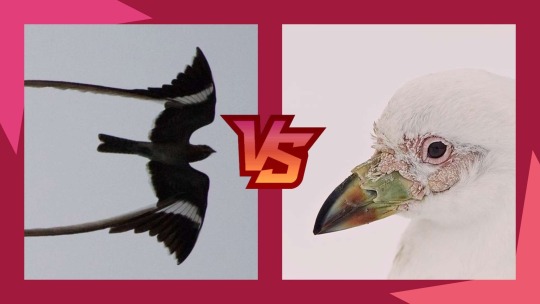
19 notes
·
View notes
Text
Also gonna post the Charadriiformes/Shorebirds prelims rn to get a head start on organizing the third bracket.
Those that received multiple nominations and are automatically IN the competition are as follows:
American Avocet
Pied Avocet
Black-necked stilt
Snowy sheathbill
Piping plover
American golden plover
Egyptian plover
Killdeer
Northern lapwing
Masked lapwing
Ruddy turnstone
American woodcock
Long-tailed jaeger
Parasitic jaeger
Arctic tern
Black Skimmer
Little Auk/Dovekie
Razorbill
Atlantic Puffin
Tufted puffin
Those who received single nominations (there were over 30) will be chosen via preliminaries! The Shorebirds bracket will begin after the Superb Owl is decided.
11 notes
·
View notes
Text


Snowy sheathbill, a scavenger of penguins (uncool). I have elected to not post the picture of the one that was covered in poop.
13 notes
·
View notes
Text
#1966 - Aptenodytes patagonicus - King Penguin
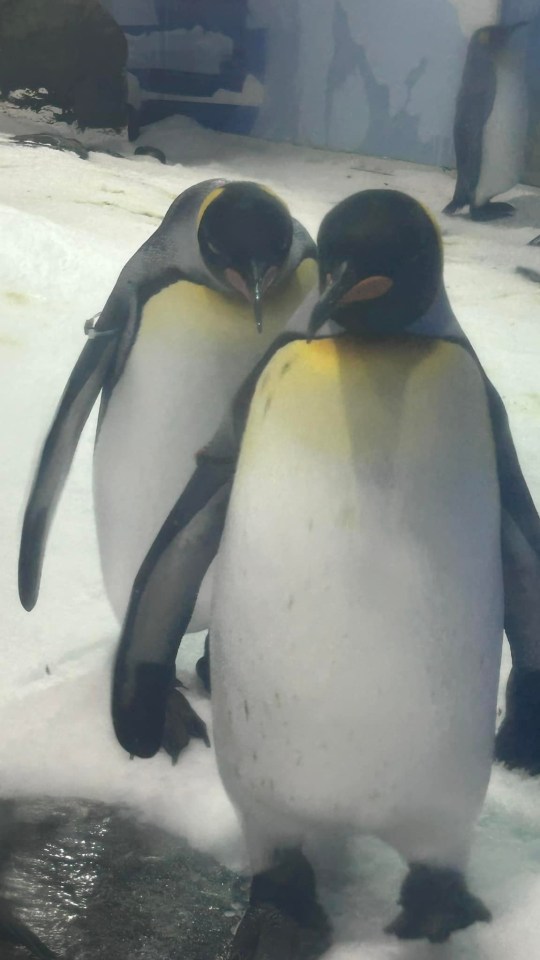
Photo by @purrdence
At up to 1m tall, the second biggest living penguin species after the Emperor Penguin. Some of the extinct species were *significantly* larger, and following the naming schema would presumably have been called God-Emperor Penguins if they were still around. And not hunted to extinction for their blubber, oil, meat and feathers. The King Penguins were certainly heading that way - by the early 1920s, the population on South Georgia and the Falklands was nearly wiped out by whalers who burned millions of penguins as fuel to render down whale blubber. Happily, the King Penguin is a protected species now - although climate models predict disastrous changes in the location of the Antarctic Convergance by 2100 and add hundreds of kilometers to the distance between their breeding grounds and feeding grounds.
King penguins mainly eat squid, krill and lanternfish, diving to over 300 metres depth in pursuit of this prey. Non-human predators include giant petrels, skuas, snowy sheathbills, leopard seals (who can notoriously turn a penguin inside out to remove the hide), Antarctic fur seals, and orca.
These penguins breed on the Subantarctic islands, South Georgia, Macquarie Island and a few others, often sharing the breeding grounds with other penguin species.
Notable King Penguins include Brigadier Sir Nils Olav, the Edinburgh-based mascot and colonel-in-chief of the Royal Norwegian Guard, and Lala the Penguin who became a viral video star after an Animal Planet special featured him venturing to a nearby market in Japan to fetch a fish with a specially made backpack.
3 notes
·
View notes